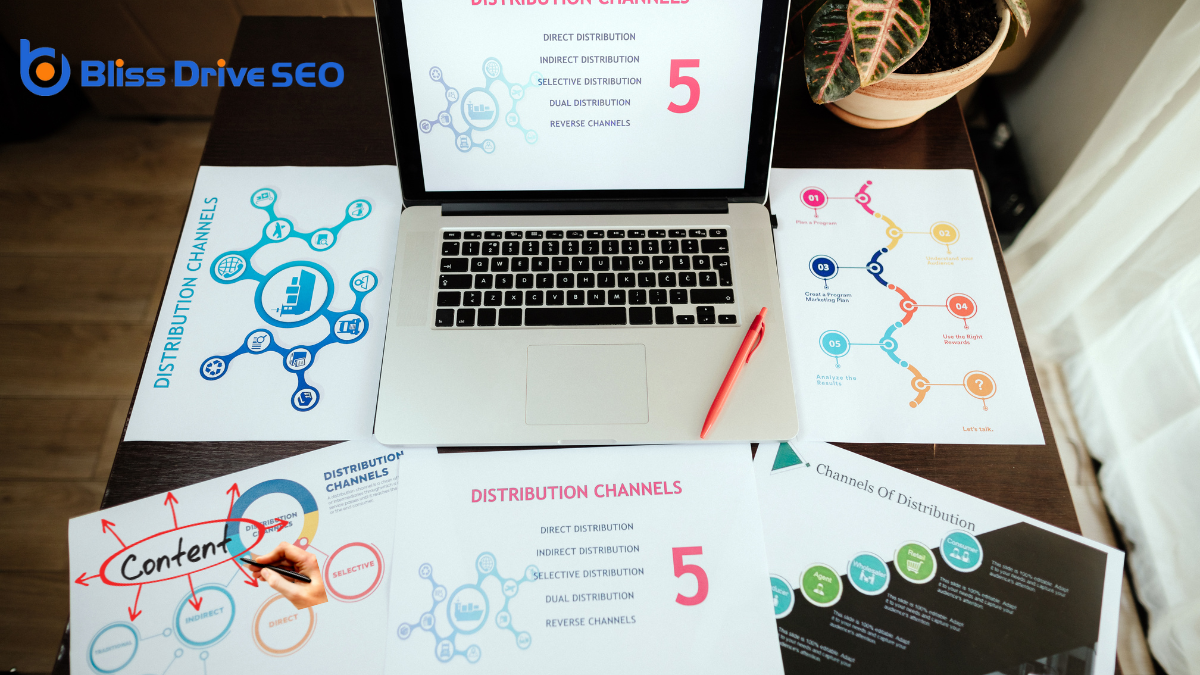Digital Marketing Services
Learn More About Us

To get started with content marketingA strategic approach focused on creating and distributing valuable, relevant, and consistent content..., first define your goals and pinpoint your audience. Identify what you want to achieve and who you're talking to. Conduct thorough market research to understand current trends and your competition. Choose content types and platforms that speak to your audience's interests and behaviors. Develop a content plan with a consistent posting schedule. Focus on creating original, SEO-optimized content that's valuable and engaging. Distribute your content across different platforms and track performance with key metrics. Continuously iterate based on feedback and analyticsThe systematic computational analysis of data or statistics to gain insights and support decision-ma.... Understanding these steps will set the foundation for a successful content strategyA plan for creating, publishing, and managing content to meet business goals..
When diving into content marketing, one of the first things you need to do is define your objectives. Clearly outlined goals act as a roadmap guiding your entire strategy. Without them, you'll find yourself adrift, struggling to measure success or adjust tactics effectively.
Start by asking yourself what you want to achieve. Are you looking to increase brand awarenessThe extent to which consumers are familiar with the qualities or image of a particular brand., drive traffic to your website, generate leads, or boost sales? Pinpointing your primary objectives will help you focus your efforts and resources in the right direction.
Be specific and realistic with your goals. Instead of saying, "I want more website visitors," aim for something measurable like, "I want to increase website traffic by 20% over the next six months." This clarity turns abstract ambitions into concrete targets. It's also important to prioritize your objectives, as trying to accomplish too many things at once can dilute your efforts and leadA potential customer referred by an affiliate who has shown interest in the product or service but h... to burnout.
Once you've defined your objectives, document them. This not only provides a point of reference but also helps keep your team aligned and motivated. Regularly reviewing these goals ensures you're on track and allows for necessary adjustments along the way.

To effectively connect with your audience, start by defining your target demographics, such as age, gender, and location.
Next, analyze their behavior to understand how they interact with your content and what platforms they prefer.
Understanding your target demographics is the cornerstone of effective content marketing. Knowing who you're talking to helps you tailor your content to meet their needs and interests.
Start by asking yourself questions like: Who benefits from my product or service? What're their ages, genders, or income levels? Consider their education, occupation, and lifestyle too. These demographic factors shape how they perceive your content and, ultimately, your brand.
To define these demographics, gather data from a variety of sources. Look at your existing customer base and identify patterns. Use tools like social media analyticsThe process of gathering and analyzing data from social media platforms to inform business decisions..., surveys, and market research reports to gain deeper insights.
Pay attention to details that might seem minor but could greatly impact your strategy. For instance, if your audience consists largely of young professionals, they might prefer content that's concise and mobile-friendly.
Digging into and truly understanding your audience's behavior is essential for crafting content that resonates. To begin, monitor how your audience interacts with your content. Look at metrics like page views, time spent on pages, and bounce rates. These insights reveal which topics keep them engaged and which don't.
Pay close attention to social media interactions. Notice what kinds of posts get the most likes, shares, and comments. This data tells you what your audience finds valuable or engaging. Don't just focus on the numbers; read through the comments and messages to grasp their thoughts and feelings.
Consider using tools like Google AnalyticsA web analytics service offered by Google that tracks and reports website traffic. to track user journeys on your website. This helps you see where users come from, what they do while they're there, and where they drop off. Understanding these patterns allows you to refine your content strategy.
Identifying your audience involves breaking it down into distinct segments based on shared interests. To do this effectively, you need to analyze the specific needs, preferences, and behaviors that set each group apart. Begin by gathering data from various sources like social media, surveys, or website analytics. Look for patterns in what your audience engages with, such as topics they frequently read about or products they purchase.
Once you've collected this data, create personas representing each segment. These personas should include details like demographics, interests, and pain points. By doing so, you can tailor your content to resonate with each group, taking into account it speaks directly to their interests and needs. This approach not only increases engagementThe interactions that users have with a brand’s content on social media. but also helps build a loyal audience over time.
To refine these segments further, keep an eye on how they evolve. Audience interests can change, so regularly update your personas to stay relevant. Engage with your audience directly—ask questions and encourage feedback. This ongoing dialogue helps you understand your audience better and guarantees your content remains valuable and compelling. By segmenting audience interests thoughtfully, you set the foundation for a successful content marketing strategy.

Before diving into content creation, conducting market research is essential to tailor your efforts to your audience's needs and preferences. Knowing your audience guarantees that your content resonates and engages effectively. Start by identifying who your target audience is: their demographics, interests, and online behavior. You can gather this data through surveys, social media insights, or existing customer feedbackInformation provided by customers about their experience with a product or service, used to improve ....
Next, analyze your competitors. Look at what content they're producing, which topics they focus on, and how their audience interacts with it. This can reveal gaps in the market or opportunities to differentiate your content.
Use tools like Google TrendsA tool to analyze the popularity of search queries over time. to identify what topics are trending in your industry and what questions people are asking.
Don't forget to explore forums, social media platforms, and blogs where your target audience hangs out. Pay attention to the discussions and the language they use. This insight can help you craft content that speaks directly to them.
When choosing content types for your marketing strategy, start by identifying your target audience and understanding their preferences.
Next, select the platforms where your audience spends their time, whether it's social media, blogs, or video channels.
To effectively kick off your content marketing strategy, you'll need to focus on your target audience. Understanding who they're is essential for creating content that resonates and engages. Start by asking yourself questions: Who'll benefit most from your products or services? What're their demographics, interests, and pain points? Gather data through surveys, social media insights, and customer feedback to sketch a clearer picture.
Once you've identified your audience, think about the types of content that will appeal to them. Are they looking for in-depth guides, quick tips, or entertaining videos? Your audience's preferences should shape your content types.
For example, if your audience is busy professionals, they might prefer concise articles or podcastsAudio content distributed through digital channels, often in series format. they can listen to on the go.
Next, create personas to represent different segments of your audience. These personas help you tailor your content to specific needs and behaviors. Imagine them as real people with unique challenges and goals. This will guarantee your content feels personal and relevant.
Choosing the right platforms for your content is essential to reaching and engaging your target audience effectively. Each platform has its strengths and caters to different audience types. Start by considering where your audience spends most of their time online. Are they scrolling through FacebookA social networking site where users can post comments, share photographs, and links to news or othe..., swiping on InstagramA photo and video-sharing social networking service owned by Facebook., or participating in LinkedInA professional networking site used for career and business networking. discussions? Knowing your audience allows you to tailor your content to fit the platform perfectly.
Think about what type of content resonates with your audience. If they're visually driven, Instagram or PinterestA visual discovery and bookmarking platform where users can find and save ideas. might be your go-to. For in-depth articles and professional networking, LinkedIn can be highly effective. If you want to engage through videos, YouTube or TikTokA social media platform for creating, sharing, and discovering short music videos. are great choices.
Don't just focus on one platform; a multi-channel approach often works best. However, don't spread yourself too thin—choose platforms you can manage effectively.
Ensure the content types you select align with your brand message and capabilities. If you're comfortable with writing, blogs and articles might be your strength. If you have the resources for video production, immerse yourself in that format. Remember, the goal is to create content that not only reaches your audience but also engages and resonates with them.
Before diving into content creation, clearly define your content goals to ensure every piece serves a purpose. Ask yourself what you want to achieve with your content. Are you looking to increase brand awareness, generate leads, improve customer engagementThe level of interaction and involvement a customer has with a brand., or drive sales? Each goal requires a different approach, and knowing your objectives upfront helps you create content that resonates with your audience.
Once you've set your goals, it's time to choose the content types that align with them. For instance, if your goal is to boost engagement, interactive contentContent that requires user interaction, such as quizzes, polls, or calculators. like quizzes or polls could be effective.
To drive traffic, consider blog posts or videos optimized for search engines. If you're aiming to nurture leads, email newsletters or whitepapersAuthoritative reports or guides that address complex issues and provide solutions. might work best. Selecting the right content type is essential, as it directly influences how your audience interacts with your brand.
Crafting a content plan is an essential step in guaranteeing your marketing efforts are both strategic and effective. Without a solid plan, you risk creating content that doesn't align with your goals or resonate with your audience. Start by identifying your target audience. Understand who they are, what they need, and where they spend their time online. This information will guide your content creation and distribution efforts.
Next, decide on the types of content you'll produce. Will it be blog posts, videos, podcasts, or social media updates? Consider what format your audience prefers and what best showcases your expertise.
Then, establish a consistent posting schedule. Consistency helps build trust and keeps your audience engaged, so decide how often you can realistically publish new content.
Don't forget to think about the platforms you'll use. Choose channels that align with your audience's preferences and your business goals.

Creating quality content starts with understanding your audience's needs and crafting unique material that speaks directly to them.
It's important to focus on originality to stand out from the competition and build trust with your readers.
Additionally, you should optimize your content for SEO to guarantee it reaches as many people as possible.
To truly excel in content marketing, you must, above all, understand the needs and preferences of your audience. Begin by identifying who they are. Are they professionals seeking industry insights or perhaps hobbyists looking for tips and tricks? Knowing their demographic information, interests, and challenges can guide you in crafting content that resonates.
Engage with your audience through surveys, polls, or social media interactions. These tools can reveal what they're curious about or struggling with. Listen actively and pay attention to feedback—it's invaluable for tailoring your content.
Don't overlook analytics either; they can show you which topics gain the most traction and which formats your audience prefers.
Once you've gathered insights, focus on delivering value. Your content should address their pain points, answer their questions, or entertain them in a meaningful way. Remember, it's not just about what you want to say, but what they need to hear.
Consistency is key. Regularly updating your content based on changing audience needs keeps them engaged and loyal. By truly understanding your audience, you'll create content that not only attracts but also retains their attention, building a strong, lasting relationship.
Originality is the cornerstone of quality content. When you create something unique, you set your brand apart and make a lasting impressionWhen an ad is displayed on a user’s screen.. To achieve this, start by tapping into your own experiences and perspectives. Consider what makes your voice distinct and how you can convey your message in a fresh way. This approach not only draws in your audience but also builds trust and authenticity.
Don't be afraid to explore new angles or offerThe specific product or service being promoted by affiliates. insights that haven't been widely discussed. Research your topic thoroughly and find gaps in existing content. By doing so, you'll provide value that others may overlook. Remember, your audience is looking for content that stands out and adds real value to their lives.
While creating original content, make sure it's clear and concise. Avoid unnecessary jargon, and focus on delivering information that's easy to digest. Use storiesA feature on platforms like Instagram and Facebook where users can post photos and videos that disap... or examples to illustrate your points, making your content relatable and engaging. This helps in keeping your audience interested and encourages them to engage with your brand.
When it comes to optimizing for SEO, your primary goal should be to create content that's not only high-quality but also strategically designed to boost your visibility on search engines. You want your content to be informative, engaging, and valuable to your audience while ensuring it aligns with search engine algorithms. Here's how you can do it:
Optimizing for SEO is a critical step in guaranteeing your content reaches its intended audience. First, you'll want to conduct keyword research to identify the terms your audience is searching for. Use tools like Google Keyword Planner or Ubersuggest to help you find relevant keywords with a balance of high search volume and low competition. Once you have your keywords, strategically integrate them into your content, including titles, headers, and throughout the text, but avoid overstuffing as it can harm readability and rankingsThe position at which a website appears in the SERP..
Next, focus on creating high-quality content that provides value. Search engines favor content that answers user queries effectively, so ensure your content is informative and engaging. Make use of internal and external links to build authority and provide additional resources for your readers.
Additionally, optimize meta tags and descriptions, as these elements appear in search results and influence click-through rates. Make them compelling and guarantee they include your primary keywords.

After ensuring your content is optimized for SEO, the next step is to focus on distribution to reach your target audience effectively. You need to put your content where your audience is most likely to find it. This means leveraging various platforms and channels to maximize your reach. Here's a step-by-step approach to help you distribute your content:
Measuring your content's performance is pivotal to understanding its impact and refining your strategy. To start, identify key performance indicators (KPIs) that align with your goals. These could include metrics like page views, time spent on a page, social shares, or conversionThe completion of a desired action by a referred user, such as making a purchase or filling out a fo... rates. By focusing on these KPIs, you'll gain insight into what's working and what isn't.
Next, use analytics toolsSoftware used to track and analyze website performance, user behavior, and marketing efforts. to track your content's performance. Google Analytics is a popular choice that provides a wealth of data about your audience and how they interact with your content. You'll see which pieces are driving traffic, engaging visitors, or leading to desired actions. Additionally, social media platforms offer their own analytics to help you assess reach and engagement.
Once you've gathered insights from measuring your content's performance, it's time to focus on iteration and improvement. This step is pivotal because it allows you to refine your strategies and create more effective content. Start by analyzing what works and what doesn't, and then make necessary adjustments. Here's how you can systematically improve your content:
To succeed in content marketing, start by defining clear goals and understanding your audience. Conduct thorough market research to tailor your strategy effectively. Choose diverse content types that resonate with your audience and develop a detailed content plan. Optimize everything for SEO to boost visibility. Distribute your content wisely across relevant channels and consistently measure performance. Use these insights to iterate and improve. With dedication and adaptability, you'll see continuous growth and engagement in your content marketing efforts.
